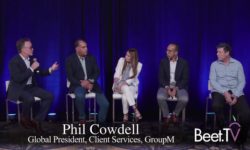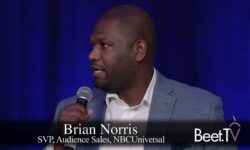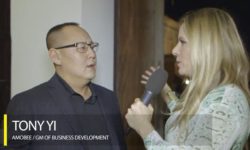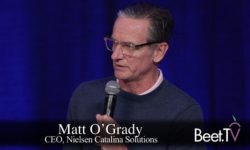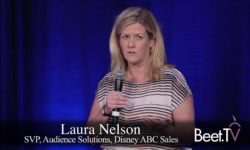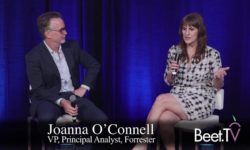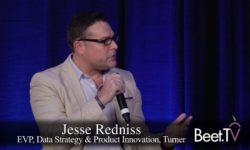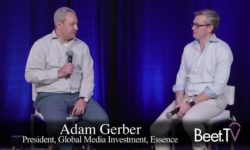SAN JUAN — It was billed as the revolution for television ad sales – the emerging prospect of using internet-connected platforms and audience viewing data to plan, execute and measure TV ad campaigns in real-time.
After all, “programmatic” advertising unleashed “real-time bidding” (RTB) on to the world several years ago now. Today, real-time auctions for display ads are commonplace and many hope for a similar arrival in TV and video.
But a panel discussion at Beet Retreat discussed ongoing inertia in a $70 billion US TV advertising business where the legacy medium is proving reluctant to change…
DISH Network director, ad sales, Dish Media, Jim D’Antoni:
D’Antoni was asked if ad buyers’ requests for audience segments are still processed “mostly in Excel and (with) manual extracts of data from various systems, lots of macros”.
He responded: “Yes. There is still some friction.
“And that’s just dealing with one supplier – if you’re on the buy side, you’re going to have to deal with that three or four times. So there is a long way to go in terms of streamlining the process.”
Videa VP sales Archie Gianunzio:
Automation is what Videa is aiming to bring to the market. The company makes platforms that reduce friction in ad avails, makegoods and posting
“We have found, much to our chagrin, that (even) within the same broadcast group … multiple stations are not speaking the same language. There’s almost no standards at all when it comes to broadcast.
“We spent probably two years on something that we called traffic normalization, which was literally just getting our system to understand all the different names that exist for one program so that when someone wants to make a buy across multiple markets, the buy could happen and the system can understand (what) they mean.”
Google Head of Telco/Video Partnerships Peter Dolchin:
Asked for the most important priority, Dolchin said: “Interoperability.”
“We like challenges, but this is clearly complex and we have some really smart, talented people at the company who understand it. We’ve been recruiting people from the industry over the past decade. And so, we know it’s hard, but we are testing in a variety of different ways.
“So with this new linear addressable solution that we’ve launched, there is the ability to look at set-top box tuning data real time and bring that into the decision making when they’re selecting the ad. That is one of the ways in which we’re bringing real time to it.”
Experian director of TV solutions, Experian Marketing Services, Brad Danaher:
Danaher said his company had helped political advertisers target campaigns during the recent US mid-term elections.
“It was a big cycle for political. Even though it was big, we actually thought it would be a little bigger.
“When we work with folks like DISH, we have a platform called Audience Engine, which basically allows counts to be accessed within seconds if needed be. If (the audience target is, for example), environmentally-aware consumers … we can tell the MVPDs through that platform within 10 seconds and you can go on the platform and know it, and then launch that into their media plan, knowing the sizing right away. That’s an improvement.”
DISH Network director, ad sales, Dish Media, Jim D’Antoni:
D’Antoni was asked to describe the typical lead time to make an addressable TV campaign active.
“Typically three to five days,” he said. “And then that it served, it’s beamed up to the satellite. It’s (then stored) in the (set-top) box.”
Furious Corp CEO Ashley Swartz:
That prompted the panel moderator to make a “broad” statement on the relative slowness of what many think should, by dint of being digital, be a fast process.
“There is no real-time in TV,” she said. “Tthere’s really very little real time data, real time insights, real time decisioning, real time delivery, realtime ops.” Fellow panelists agreed, though Google’s Dolchin explained that Google has launched a linear addressable TV ad solution which supports examining set-top box tuning data in real-time.
Videa VP sales Archie Gianunzio:
Gianunzio said he thought a lot of the infrastructure inertia remains in place because few inside the legacy TV business perceive a threat driving need for change.
“Within TV, things have always been relatively rosy. There’s this feeling that, ‘No matter whatever came along, we were going to be able to deal with it’.” He cited DVRs, internet and Netflix as examples of purported TV-killers that have not turned out to be.
“Every article that you read is like ‘The audience is down and yet it’s more important than ever that you’re using television to get your message out there’ – Facebook and Uber are (doing just that).”
But Gianunzio sees a change may finally be coming.
“The people who thought ‘we’re just going to go passed this and we’re not going to have to actually deal with it’ … they’re either retired or they realize that they’re not going to get to retirement without dealing with it. I think that’s what’s going to push us there.”
This video was produced in San Juan, Puerto Rico at the Beet.TV executive retreat. Please find more videos from the series on this page. The Beet Retreat was presented by NCC along with Amobee, Dish Media, Oath and Google.







